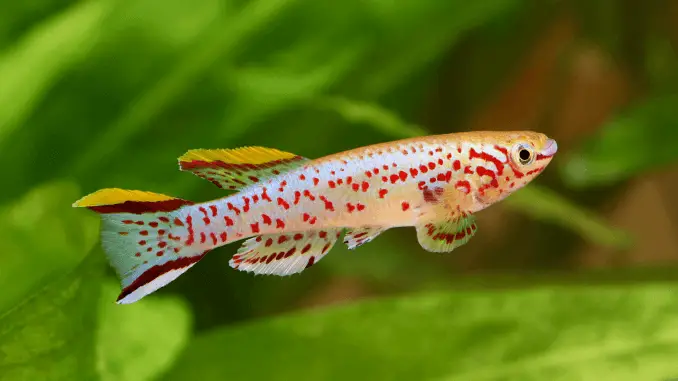
Killifish are a hardy, mostly freshwater, egg-laying family of fish that can be found across the Americas, southern Europe, African, and even the Middle East and Asia.
They are one of the most vibrantly colored and beautifully patterned freshwater fish. For this reason, killifish enthusiasts are one of the largest groups of fish-keeping enthusiasts around.
Killies are usually sold under their Latin names, which can make it difficult for beginners to know exactly what they are buying, so care must be taken when researching and deciding on which species to keep.
Let’s take a look at an overview of killifish and their needs, so you can decide whether they are the right aquarium fish for you.
TABLE OF CONTENTS
Learn More: Download the Killifish Guide now to find out about their ideal tank mates, dietary and habitat needs.
Killifish Facts & Overview
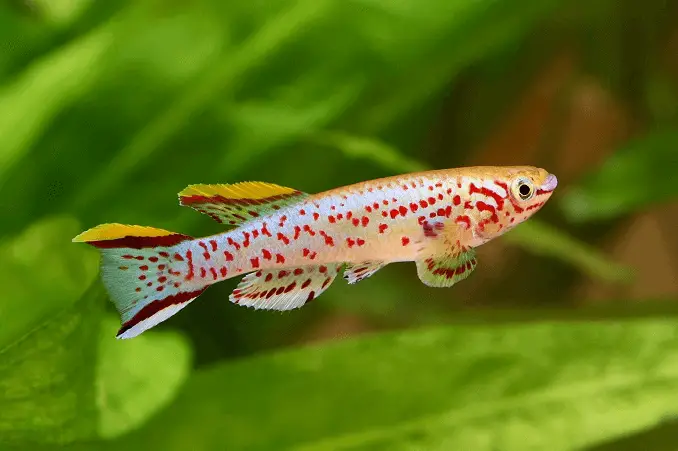
| Category | Rating |
| Care Level: | Easy-difficult (species dependent) |
| Temperament: | Most species are peaceful |
| Color: | Vividly colored |
| Lifespan: | 3 months – 5 years (species dependent) |
| Size: | 2-9cm |
| Diet: | Carnivore |
| Family: | Cyprinodontiformes |
| Minimum Tank Size: | 20 gallons per pair |
| Tank Setup: | Very simple; bare floor, minimal light, sponge filter |
| Compatibility: | Community safe with caution (species dependent) |
Cyprinodontiformes, commonly known as killifish, is a family of fish that encompass more than 1,250 types of killifish species. These species are then classified into ten different groups.
The killifish family is a very diverse and widespread group of fish. They have adapted to live in a huge range of different habitats and are found in almost all continents across the world, except for Australia and Antarctica.
Killifish are mainly found in shallow subtropical and tropical waters.
They inhabit both still and moving waters, and are mostly freshwater fish. However, there are a few species that also live in brackish and saltwater.
In their natural environment, some killifish (Annual Killies) have a lifespan which only lasts for a few months.
Although the term ‘killi’ sounds like it might be dangerous, killifish did not derive their name for that reason. ‘Killy’ is actually derived from the Dutch word meaning ditch or channel.
The vast majority of killifish are only one or two inches in size, with larger species reaching up to six inches.
Appearance
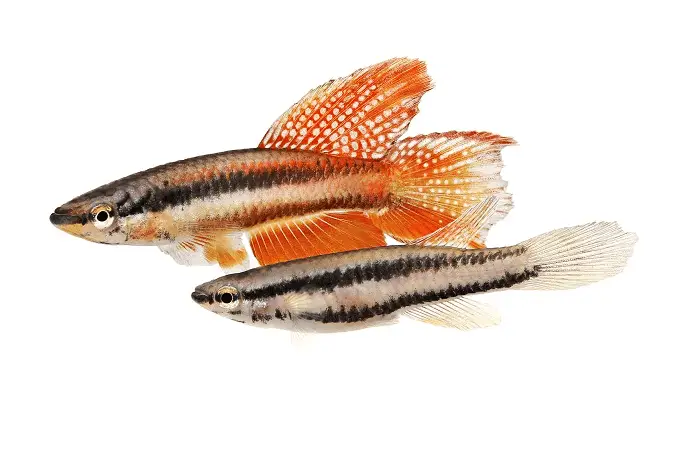
Killifish vary widely in appearance. One thing most of them do have in common though is the bright colors and vivid patterns.
The males are much brighter than the females, and most killies’ heads are flat at the top. Their mouths are at the tip of their face or underneath and their teeth are long, curved, and pointed.
The majority of species have round scales and no barbels.
Most killifish are slender and pike shaped, which makes them great swimmers. Some have a more cylindrically shaped body with short rounded fins and others have long broad fins.
The body shape varies depending on the species, but they all have a dorsal fin set towards the back half of their body. In most species, males also have larger dorsal and anal fins.
As mentioned before, most killifish are between one and four inches.
Some of the smaller species include The Dwarf Madeka (Oryzias minutillus) and the Hummingbird Lampeye (Poropanchax myers) are less than one inch in length.
An extreme example of a larger killifish is The Orestias (Orestias cuvieri) which can grow up to ten and a half inches.
Perhaps the most useful way to help you decide which type of species you want is to look at the characteristics and care requirements of individual species.
Behavior and Compatibility
Most killifish are peaceful and get along well in community tanks; however, the males can be aggressive towards each other.
For this reason, if you’re a beginner we recommend you keep a pair of killies in a species-only tank.
However, if you are experienced and want to keep a group of killies in a larger tank, you can do so as long as you provide plenty of retreats and hiding spaces.
Alternatively, you can just have one male killifish in each aquarium, and avoid keeping any similar-looking male species.
You can keep any number of females together.
Killies are usually good community fish and can be kept with other small, peaceful species that require similar water conditions, such as neon tetras and rummy nose tetras.
There is one trait of killies behavior that is VITAL that you know about while setting up your tank – almost all of them are incredible jumpers!
For this reason, you should make sure you cover your tank with a hood and ensure its security. Given the small size of killies, they can jump through very small gaps.
Aquarium Requirements
This section will provide a general overview of killifish tank conditions. It’s important to read this advice alongside specific species advice.
In the wild, killifish inhabit a vast range of places, most killifish are also quite hardy and so, therefore, replicating their natural settings into a tank setting isn’t too difficult.
The tank size and setup will depend on how many fish you want to keep and what your reasons for keeping them are.
Whether you keep your killies in saltwater or a freshwater tank will also depend on the species.
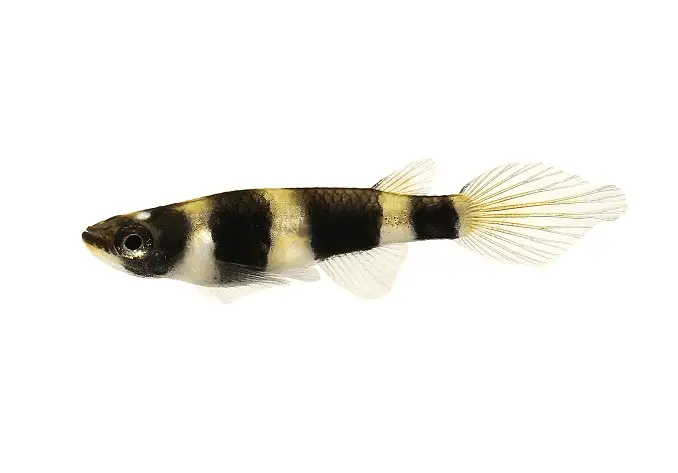
Tank Setup
A 20 gallon tank is perfect for a regular pair of killifish; if you are opting for one of the larger species you adjust your tank size accordingly.
Most killies should be in a long shallow tank with very little, or no water movement. Your tank should have plenty of live plants, mainly floating plants.
Plants that are suitable include the cryptocorynes. This is because they do well with low levels of lighting.
The tank can be bare on the floor, but most people like to cover it with dark gravel. If you do choose to use gravel, you should choose a type that will not harden the water.
If you’re wondering what other things you should not put in your tank, you can read this article.
Don’t use gravel if you intend to get bottom spawners, instead you can use peat (as long as it doesn’t contain fertilizers or additives).
You should also provide some hiding places for your killies; this can be in the roots of the floating plants, rocks or wood.
Tank Conditions
The water conditions of your tank depend entirely on the species of killifish which will inhabit it.
The majority of killifish require water temperatures of 72-75oF, if you have just a single tank you can use a regular aquarium heater, however, more serious killifish keepers who have a room full of tanks may instead heat the whole room.
The pH balance is different in each Killifish tank because each and every Killie has a different preference. For example, some come from soft acid waters and others inhabit hard alkaline waters.
For most killies, a water hardness of 120-160 ppm is appropriate, the water hardness is not as critical to get right as the pH balance, although there are a few species that require soft (better for breeding) or hard water (for example, the Nothobranchius).
The lighting again depends on the species; most killies are used to shade from direct sunlight and so prefer low lighting tanks.
The majority of killifish require low water movement or no water movement at all.
As for filtration, if you choose to have a small tank, you’ll most likely need to use a filter (unless you’re prepared to do small frequent water changes).
Small tanks are much easier to pollute than larger ones, as waste products build up quickly.
A filter will break down toxins, and the most common type to use in a small tank is a simple box filter with a filter sponge or filter wool.
If you have a large aquarium, you might choose to use under-gravel filters.
Diet
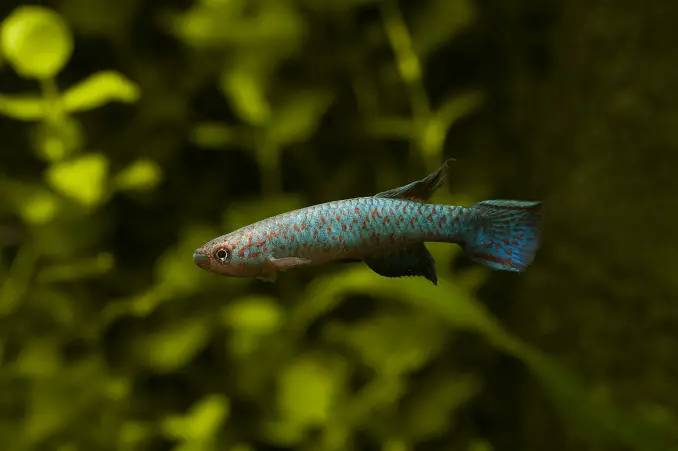 Killifish are mostly carnivores, and in their natural environment, they eat crustaceans, insect larvae, and worms.
Killifish are mostly carnivores, and in their natural environment, they eat crustaceans, insect larvae, and worms.
Some are omnivores and include algae in their diet.
In an aquarium, most killifish require live foods, therefore if you are not able to provide live food, or are hopeful that you might be able to switch them over to flake food – they’re not the right fish for you.
A varied and well-balanced diet is particularly important if you are breeding killifish. For this reason, a lot of experienced aquarists choose to make their own food so they can meet the exact nutritional requirements of their fish.
The best foods for adult killifish include:
Brine Shrimp – easily taken by most killies, good nutritional source. You can also try frozen brine shrimp.
Daphnia – most aquarists use this live food. It can be cultured or collected from ponds (care must be taken not to collect other organisms or fish).
It should not be used as an exclusive food source as too many can act as a laxative.
Mosquito Larvae – only available seasonally, can be collected from ponds.
It can also be cultured by leaving a container of water to become green with algae, however, you must be careful not to allow a full life cycle and breed mosquitos.
Tubifex Worms – can be bought from stores, excellent food source but can carry disease. To reduce the risk of disease being spread to your fish, rinse the worms thoroughly under cold water in a shallow tray.
Black Worms – similar to tubifex worms. An excellent food source, some companies grow them for profit so usually easy to get hold of.
White Worms – excellent food, but can be fatty so it should not be an exclusive food source.
There are other foods that can be fed to killies such as
- Fruit Flies
- Beef Heart
- Paste Foods
- Dry Foods
The main thing to bear in mind is that a variety of the above is ideal. Too much of one food is never great.
If you’re breeding killies, you’ll also need to know what to feed the Fry.
The most suitable foods for newly-hatched killifish fry are; newly-hatched brine shrimp, vinegar eels, microworms, infusoria, and grindal worms.
Breeding
Killifish are actually very easy to breed, and this is perhaps the top reason that they are so popular with Aquarists and have such a huge fan base.
If you want to breed killifish, it’s important to know that there are two different reproductive types.
One is the annual killifish; the other is the non-annual killifish.
Annual Killifish
In its natural environment, the annual killifish lives in a non-permanent body of water that drys out each year killing the fish.
Therefore these fish have adapted to grow and reach sexual maturity extremely quickly, usually within a few weeks. They lay their eggs in the peat moss and they hatch when the water returns.
In the aquarium environment, they will need a small breeding tank with sand or a peat moss substrate where they can bury their eggs.
Once the eggs have been laid, the water and the parents should be removed and the substrate should be kept warm and moist for around 3 months.
After this time, water can be added again and the fry should hatch.
Annual killifish have a life expectancy of up to 2 years in an aquarium.
Non-annual Killifish
The non-annual killifish’s natural habitat does not dry out. The eggs incubate in water, for a much shorter period of time.
They will need a much barer tank. Some breeders like to include some fine-leafed plants; however, it can be difficult to remove the eggs from plants.
If you choose to include plants, you’ll want to remove the parents soon after they have laid eggs to stop them from eating the eggs.
Non-annual killies have a long lifespan and grow much more slowly than annual killies.
Where to Buy Killifish
As we mentioned early, it’s rare to find killifish for sale in regular fish or pet stores, and if they do stock them they will normally only have one or two species.
Most people buy their killifish online, from breeders and hobbyists, or at auctions.
When you buy your killifish, you should choose healthy-looking fish, and also ensure they match the description of the species you are choosing.
Many species of killies can look similar, and some are misidentified in pet stores.
It’s important to know exactly what you’re buying so you can provide the right tank conditions for your fish.
Should You Keep Killifish
Are you an experienced aquarist looking to keep one of the most well-loved fish in the hobby?
The killifish can be an enjoyable and rewarding breed to keep, especially if you want to breed them. If you join a killifish enthusiast group, you’ll be well supported and there will always be someone on hand to give advice.
If you’re new to fish keeping, we recommend you don’t keep killies as your first fish.
Most beginners dive in head first, and without the experience of keeping less complex fish first, you’re bound to make mistakes.
Perhaps start with a peaceful community fish, if you’re set on keeping killies eventually, choose those that are compatible so you can add them in a few years’ time when you have more experience.
Frequently Asked Questions About Killifish
- How long can a killifish live out of water?
- Are clown killifish aggressive?
- How many clown killifish should I get?
- Can you mix different types of killifish?
- How long do killifish live?
- Are killifish easy to breed?
- Are killifish bottom feeders?
- Can killifish live with shrimp?
- Will killifish eat small fish?
- Do killifish need an air pump?
- Can killifish live with bettas?
- Can killifish live with neon tetras?
- Are killifish fin nippers?
- What fish can live with killifish?
- Are killifish edible?
- Are killifish hard to keep?
- Are killifish aggressive?

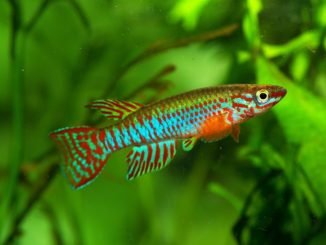

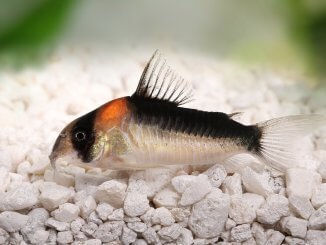
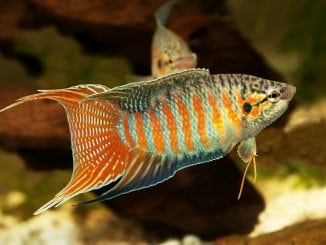
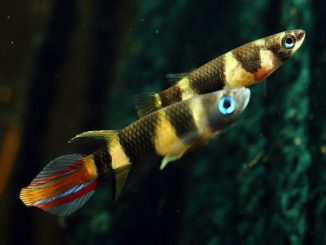
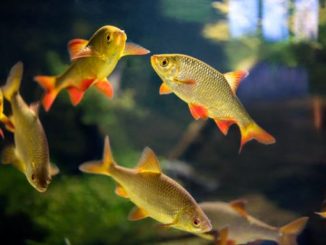
Yes I’m ready to keep killis I have plenty of experience
Hi Charles,
Thanks for sharing your experiences with us, it’s always best to do plenty of research first. Unfortunately many pet stores are just not adequately trained in providing the right advice. Good luck with your future tanks!
Robert.
Love it. I did the same thing, with the same fish, from the same company. My male died within 3 days as well. I thought the same. His lip was broken.
I do love my female. She has quite a character. Being territorial we have to work together. There are some tools she hates . And gives me maybe 5 mins at a time in the water. I own a 90 gallon w 23 species and counting. And shes the head mother. Alpha .
Unfrozen krill ,freeze dried shrimp,white worms ,and live snails are her faves.
I bought a killi at a big box pet store, and although it seems to be getting on fine with the other fish in my community tank, I suspect it ate my freshwater shrimp. I had a variety of shrimp including some larger Amanos and some smaller Neocaridina. The Amanos are fine, but all but one of the neos have disappeared. The remaining neo tends to hide in the base of a plant.
Does this sound like typical killi behavior?
Hi Adam, yes – Killis are carnivores so it’s not surprising they ate any small shrimp which you have. Robert
YES, BEING OMNIVORES, THEY WILL EAT INSECTS, WORMS AND SHRIMP
I have no trouble raising killies and other types of fish. My problem is, I can’t get any eggs to hatch.
I follow everyone’s way of doing it, but no luck.
I haven’t seen any eggs, eyed up or not.
I have bred and raised live- bearers, and egg layers for over 20 years. I sold a ton of fish to a large pet store.
I have been ( my salt water aquarium ) featured in a fish magazine 25 years ago. Plus praised highly for my success in breeding and raising Corydoras . That was also 25 years ago. Now I think everyone does it.
I have sold over 60 brisrlenose plecos in the last year.
So…with my experience…what am I doing wrong? I am also waiting for very high quality and beautiful, show guppies.
But I have greater hope of breeding them, as I have sold,many hundreds of them over the years. Plus Mollies, Zebra danios, leopard danios, etc. Some cichlids.
I had a professional breeder come and look at my fish set up. When he saw one of my female guppy breeders. He was amazed. The guppy was over 5 inches long, not counting tail fin. He catches a lot of fish in the wild, and said he had never seen a female guppy that size, except in the wild.
I think I was successful, because I raised my own food for them. Plus I used marbles as substrate in the breeding tanks. That way no babies got eaten.
Anyway I raise several types of live feed now, and give the fish a big variety, including flakes, freeze dried and and frozen food as well. ATM I am raising way too much feed for the fish I have now. So I freeze a lot too.
Ok, back to my Killies. I have on order every kind of Killifish I could find. Plus at least 300 I tried, with no success, to hatch. Any ideas on what I may be forgetting to do? The first batch, I think I stared the eggs to death, lol.
You have a wonderful magazine. Thank you for letting me join.
Brenda
Hi Brenda, it’s so good to have someone with so much breeding experience as part of our community. I don’t have any personal experience breeding Killifish but I will leave your question here in the hope that someone will see it who can offer some advice. Thanks, Robert
Hi Brenda! I got my first golden wonder killifish about 1 year ago and he was maybe an inch. I got him a female maybe 3 months later, many people recommend 2+ females for every Male. But both genders did just fine and I made sure to include many plants and structures to hide in/ from. It varies heavily on the species! I currently have 9 surviving offspring and 3 fry from last week. My golden wonders love the brackish water and I really think the water is important. I’m not a professional and I don’t keep pH balances for my fish because they’re just really hardy. They have to have meat, too. Mine loved when I could pick up some shrimp as live food every once in a while. Another tip is that the parents love to go at it just to eat the eggs afterwards, so maybe after a day of seeing them dancing switch them to a parental tank. I never did for mine because they were always rubbing and dancing. I started off with 31 fry and most of the ones that got big first ate the smaller, newer borns. Then I divided the fry up by size. And my male is such a beautiful fish, I swear I tell him 3x a day. I’m pretty sure he’s a bit bigger than 4 inches though.
-Antonia Castro
how can you tell the difference between males and female golden wonder killi’s?